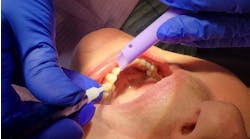Functional Orthodontics: The Foundation of Whole-Body Dentistry
When my 8-year-old daughter could not breathe through her nose and her lower incisors erupted on top of one another, it took an introductory course in functional jaw orthopedics to see the connection. That one-day course transformed my practice, my career, and my life from tooth dentistry to whole-body dentistry and wellness.
Functional jaw orthopedics has at its foundation balanced function of all components of the stomatognathic system. Properly developed arches, properly positioned mandible in relation to the maxilla, and correct vertical dimension all contribute to balanced function of the head, neck, and facial muscles. The functional philosophy is a nonsurgical, nonextraction treatment - mothers will do anything to help their children avoid surgery or extractions or both. Because of its emphasis on balanced function at any age, functional orthodontics is directed at early treatment for children or two-phase orthodontics. The functional and skeletal problems are addressed in Phase 1 at ages 6 through 9. These issues include habits, airway obstructions, and skeletal discrepancies. We create a smile for the child to “grow into.” Phase 2 addresses tooth alignment when all the permanent teeth are erupted and the child is nearing the pubertal growth spurt - typically ages 12 through 15. Braces become a finishing technique, bringing beautiful esthetics from proper function.
As in all fields of health care, a proper diagnosis is necessary to develop a path of treatment. Comprehensive diagnostic records consisting of panoramic and cephalometric radiographs and analyses, photos, models, and a thorough clinical examination are an absolute starting point for good orthodontics/orthopedics.
One of the first things I look for in a child with a malocclusion is proper breathing. Enlarged adenoids lead to mouth breathing, which, in turn, contributes to narrow arches and retrognathic mandibles as the child’s body adapts to keep the airway open. The tongue cannot posture in the palate and exert lateral pressure on the teeth. The maxillary arch becomes narrow and holds the mandible in a retruded position. Enlarged tonsils contribute to forward growth of the mandible as the tonsils encroach upon tongue space posteriorly. Parents of these children often report bruxing at night, which is another adaptation to keep the airway open and allow the Eustachian tubes to drain. Good communication with otolaryngologists is key to getting treatment for these children.
Once an airway obstruction can be ruled out or treated by tonsil removal or adenoid removal or both, treatment for the malocclusion can begin. I always begin with proper development of the arches. After complete records are taken, I begin to look at the width of the maxillary arch. Studies by James McNamara and others recommend 36 to 39 mm width between the mesiolingual margins of the maxillary first molars as a guideline to accommodate all the permanent teeth. I also look at the inclination of the maxillary incisors, which can trap the mandible when too vertical or lingual. There are many appliances to develop the arches, including removable Schwarz appliances and fixed Series 2000 appliances. These can be selected based on patients’ and parents’ particular needs.
When I first began orthodontics, an oral surgeon advised me to stay away from Class II malocclusions. With 70 percent of malocclusions being Class II, and 80 percent of those having retrognathic mandibles, not treating those patients is not an option. Class II Division I malocclusions present with retrognathic mandibles - the maxilla comes through the door before the mandible. Class II Division II malocclusions present with deep overbites and an accompanying overclosed vertical dimension. These patients frequently present with multiple symptoms relating to temporomandibular disorders such as headaches, neckaches, ear pain and stuffiness, and clicking and popping TMJs. Retrognathic mandibles and deep overbites usually place the condyles in a posterior/superior position in the glenoid fossa, which encroaches upon the bilaminar zone containing the blood vessels and nerves to the head, neck, and facial muscles. Treatment for Class II malocclusions include appliances such as a Rick-A-Nator to open the vertical, or the removable Twin Block and fixed MARA appliances to bring the mandible forward.
While treating them orthopedically/orthodontically to correct the malocclusion usually improves the TMD, this opens a door for another sector of patients who have TMD signs or symptoms but who are not necessarily seeking orthodontic treatment.
Only 5 percent to 10 percent of dentists treat temporomandibular disorders at all, and many are treating as we were taught in dental school with maxillary flat-plane splints at night. Frequently, these appliances allow the mandible to retrude farther and distalize the condyles even more - in essence, making the condition worse. As a TMJ patient myself with clicking and popping TMJs for 17 years without an answer, I found that functional orthodontics/ orthopedics helped me both as a practitioner and a patient for prevention and treatment of the many aspects of TMJ disorders and the related head, neck, and facial pain.
Proper jaw position and joint stabilization are critical for successful orthodontics, restorative dentistry, and overall health. Countless people seek medical treatment for headaches, neckaches, backaches, and other pains with numerous expensive, and invasive tests to find nothing wrong. They usually end up with prescriptions for muscle relaxants, painkillers, and antidepressants that don’t address the causes - underlying musculoskeletal imbalances associated with improper jaw position. The lucky patients end up in chiropractic or osteopathic offices where improving musculoskeletal imbalances is primary. Treatment usually consists of a mandibular normalizing orthotic fabricated according to complex diagnostic records. These include computer joint vibration analysis, surface EMG testing, lateral and AP TMJ tomograms, lateral and PA skull films, and models mounted on the Accu-Liner articulator to correct anterior/posterior position, vertical dimension, and maxillary cant.
While we routinely evaluate airway obstructions in children, many adults suffer from nightly airway collapse in the form of sleep apnea and sleep disordered breathing. “Do you snore?” can open the door for life-saving treatment for obstructive sleep apnea. Sleep apnea is defined as cessation of breathing for 10 seconds or more five or more times per hour of sleep. This cessation of breathing triggers sympathetic nervous system activation, which elevates blood pressure and heart rate. These patients have frequent awakenings throughout the night that prevent them from achieving deep, restorative sleep. Their quality of life is impaired by daytime sleepiness and increased incidence of motor vehicle and work-related accidents. Diagnosis of sleep apnea has been done through polysomnography, or overnight sleep studies done in a sleep laboratory. New technologies such as the Watch_PAT 100 allow patients to undergo such studies at home in their normal sleep environments. Diagnosis must be made by a physician, but the dentist becomes the first line in screening, referral, and education.
The gold standard of treatment for sleep apnea has been Continuous Positive Airway Pressure, or CPAP. This device is in essence a reverse vacuum cleaner, forcing air through the nose to keep the airway open. Compliance is poor - less than 25 percent of patients continue to use the CPAP after 90 days.
A more acceptable treatment for most patients is the use of oral appliances to keep airways open while sleeping. Fabrication of these appliances can be accomplished with a high degree of predictable success using a rhinometer and pharyngometer. These diagnostic devices use sound waves to measure the cross-sectional area of the oropharyngeal airway and are used at each step of the process to ensure the airway is patent with the appliances. Sleep dentistry is working to make oral appliance therapy the first line of treatment for sleep apnea.
Functional orthodontics provides the foundation for complete, whole-body dentistry. With a complete understanding of airway obstructions, stable TMJ position, and balanced muscle function, dentists can treat whole patients - not just their dentition. Proper function leads to beautiful esthetics and an improved quality of life. Because mothers are requesting functional orthodontics and since most patients seeking treatment for TMD or their snoring partners are female, women dentists are treating with an empathetic understanding of their patients’ needs.
null
References
1 Garry J. Upper airway compromise and musculoskeletal dysfunction of the head and neck. 1988.
2 Rondeau B. Orthodontics for the general practitioner, course manual. 2003-04.
3 McNamara JA, Brudon WL. Orthodontic and orthopedic treatment in the mixed dentition. 1996.
4 Rondeau B. The Rick-A-Nator appliance. The Functional Orthodontist, Jul/Aug 1990;7 (4).
5 Rondeau B. Twin block appliance. The Functional Orthodontist. Mar/Apr 1995; 12 (2).
6 Rondeau B. Twin block appliance, Part II, The Functional Orthodontist. Mar/April 1996; 13 (2).
7 Rondeau B. MARA appliance. The Functional Orthodontist. Summer 2002; 19 (2).
8 Olmos S. Mini residency diagnosis and treatment TM disorders. Institute for Advanced TMJ Studies, Course Manual, 2002-03.
9 Lavie P, Pillar G, Malhotra A. Sleep disorders diagnosis, management and treatment, 2002.
10 Sullivan CE, et al., Reversal of obstructive sleep apnoea by continuous positive airway pressure applied through the nares, 1981 Apr 18;1(8225):862-5.
11 Bernstein A.K, Reidy R.M. The effects of mandibular repositioning on obstructive sleep apnea. J Craniomandibular Prac 1988;6:179-81.
12 Hoffstein V, et al., Acoustic reflection has been proven to measure cross section area of upper airway. Chest. 1991 Jul; 100( 1): 81- 85.
13 Katz I, et al., A reduced cross-sectional area of the hypopharynx - risk factor for OSA & snoring. Am Rev Respir Dis. 1990 May;141(5 Pt 1): 1228-1231.
14 Smith S.D. Mandibular advancement through the use of an oral appliance has been proven to be effective in enlarging the cross-section area of the pharynx in patients with high risk factors (reduced cross-section area) for OSA. Cranio 1996 Oct; 14( 4): 332- 343.
Dawne Slabach, DDS
Dr. Slabach focuses on orthodontics, TMJ, sleep disorders, and general dentistry with whole-body wellness at the Craniofacial Care Centre in Worthington, Ohio. Reach her at [email protected].







